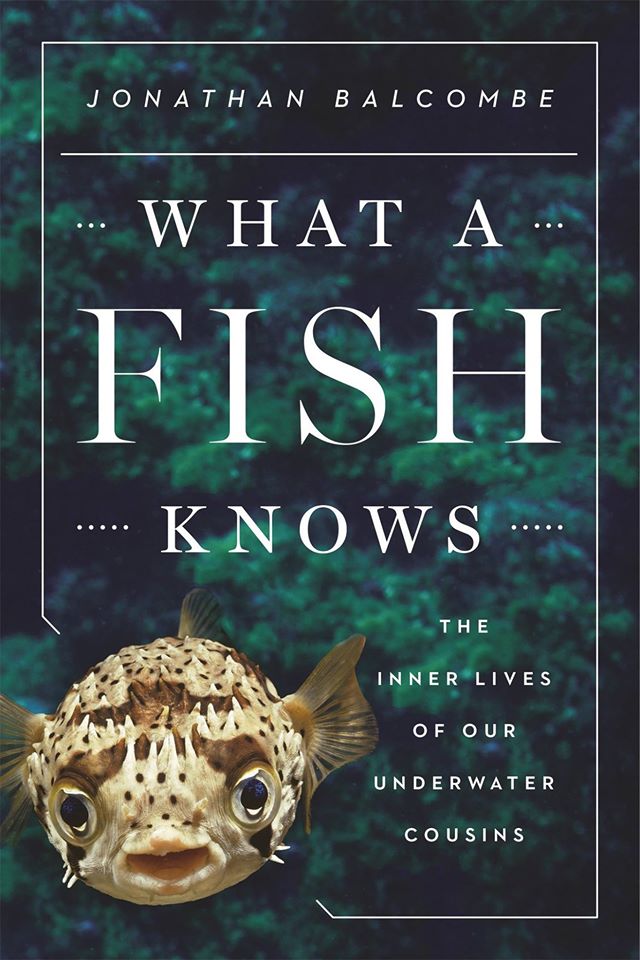We are thrilled here at VeggieVision TV to share the work of the brilliant Jonathan Balcombe. Jonathan and I first chatted nearly 6 years ago and and his incredible work as a passionate vegan, a scientist, ethologist author and speaker has led to an inescapable conclusion: fishes think and feel.
Jonathan Balcombe is the director of animal sentience at the Humane Society Institute for Science and Policy and the author of five books, including What a Fish Knows and Second Nature. A popular commentator, he has appeared on Fresh Air, The Diane Rehm Show, the BBC, and the National Geographic Channel, and in several documentaries, and has contributed features and opinions to The New York Times, The Washington Post, The Wall Street Journal, Nature, and other publications. He lives in Florida (although originally is from Essex – Yay!). Find him on Facebook, follow him on Twitter at @Jonathanpb1959, and visit his website at jonathan-balcombe.com.
In March of this year, two marine biologists published a study of giant manta rays responding to their reflections in a large mirror installed in their pool at Atlantis Aquarium in the Bahamas. The two captive rays circled in front of the mirror, blew bubbles and performed unusual or repetitive body movements as if checking to see if their reflection moved when they moved. They did not appear to interact socially with their reflections, suggesting they did not perceive what they saw as other individuals. The scientists concluded that the mantas appear to be recognizing their reflections as themselves.[1]

Jonathan Balcombe
Mirror self-recognition is a big deal, for it indicates self-awareness—a mental attribute previously known only from such brainy beasts as great apes, dolphins, elephants, and magpies.[2]
We don’t usually think of fishes as smart, never mind self-aware. As a biologist who specializes in animal behavior and emotions, I’ve spent the past four years exploring the science on the inner lives of fishes. What I’ve uncovered indicates that we grossly underestimate these fabulously diverse marine vertebrates. Because fishes inhabit vast, obscure habitats, science has only begun to break the surface on their private lives.
But the accumulating evidence leads to an inescapable conclusion: fishes think and feel. They are not instinct-driven or machinelike. Their minds respond flexibly to different situations. They are not just things, they are sentient beings with lives that matter to them. A fish has a biography, not just a biology.
Those giant manta rays have the largest brains of any fish,[3] and their relative brain-to-body size is comparable to some mammals.[4] But what about a frillfin goby? At five inches long, with prominent eyes, and slightly puffy cheeks looking down on a pouting mouth, the frillfin won’t strike you as an Einstein among fish. But what these humble dwellers of intertidal zones can do with their minds might cause one to reconsider.
At low tide, frillfins hide in rocky tide pools. If danger lurks—a hungry octopus, say—the goby will jump to a neighboring tide pool with remarkable accuracy.
How do they avoid making a leap of faith and ending up on the rocks? A series of captive experiments dating back to the 1940s found something quite remarkable. They memorize the tide pool layout while swimming over it at high tide! They can do it in one trial, and remember it 40 days later.[5]
So much for a fish’s legendary 3-second memory.
If a fish’s brain can achieve that, what else might it be capable of? What about tool-use?
Once thought the sole province of humans, tool-using behavior has now been discovered in a wide range of animals, including fishes. A YouTube video shows an enterprising tuskfish uncovering a clam by blowing water on the sand. The tuskfish then carries the mollusk in his mouth to a nearby rock, then smashes it with a series of well-coordinated head flicks and releases.[6]
This is more than tool-use. By using a logical series of flexible behaviors separated in time and space, the tuskfish is also a planner.
Many fishes hunt cooperatively, as lions do. Last year I watched from a balcony as a phalanx of predatory fishes made coordinated lunges at a school of herrings they had trapped along a Puerto Rican shoreline. In their desperation to escape, some of the herrings temporarily beached themselves.
 On reefs, collaborative hunting has reached new heights of sophistication. A hungry grouper spies a moray eel resting in a crevice, then hurries over and performs a head-shaking gesture to invite the eel to join in a foray. The two fishes—who probably know each other, for individual recognition is the norm in fish societies—then swim off like old friends on a stroll.
On reefs, collaborative hunting has reached new heights of sophistication. A hungry grouper spies a moray eel resting in a crevice, then hurries over and performs a head-shaking gesture to invite the eel to join in a foray. The two fishes—who probably know each other, for individual recognition is the norm in fish societies—then swim off like old friends on a stroll.If the grouper chases a fish into a reef crevice, the slender eel goes after it; if the hapless prey escapes to open water, the grouper is waiting. Both partners eat more when they collaborate.[7] Groupers also use their bodies to point to hidden prey, sometimes waiting for minutes before the moray responds. Biologists call this “referential signaling,” an advanced form of communication rarely seen in nature.[8]
Elsewhere on the reef, small cleaner-fishes make their living by plucking parasites and algae from a variety of “client” fishes who queue up to wait their turn. It’s a snack in exchange for a spa treatment. A busy cleaner-fish may service hundreds of clients in a single day.
It gets Machiavellian.[9] Because some cleaners do a better job than others, waiting clients carefully watch cleaners and rate them according to their track record.[10] If a cleaner oversteps her bounds and nips some tasty mucus from a client’s skin, other clients may go elsewhere for service. This, in turn, explains why cleaner-fishes perform better when they have an audience. They also may boost their reputations by pausing to caress clients with fluttering pectoral fins.[11]
How do we know that getting caressed feels good to a fish? They ask for it. Friendly groupers will swim up to divers to receive strokes, moray eels will cuddle with trusted divers, and sharks of various species seem to love receiving face and belly rubs from experienced divers (don’t try this at home).[12]
And it’s therapeutic. In a study of 32 striated surgeonfishes collected from the Great Barrier Reef, researchers stressed their subjects by placing them individually for 30 minutes in a bucket with just enough water to cover their bodies. Then, when given the chance, the frazzled surgeonfishes repeatedly sidled up to a realistic mechanical model of a cleanerfish that was rigged to deliver gentle strokes. Their stress levels—measured as cortisol in a blood sample taken from the tail vein—plummeted.[13]
If confinement to a small bucket upsets a fish, think what suffocation, crushing, or bleeding feel like. Sadly, that’s how most of the half trillion[14] or so fishes die each year when we haul them from their homes to be eaten, fed to farmed fishes, fed to livestock or pets, or tossed back usually dead or dying as unwanted bycatch.[15] Lined up end to end, they would reach the sun.
Most of the fishes we catch were wild. As we have driven many charismatic mammalian species to near extinction, so it is with cod, plaice, swordfish, halibut, and tunas—massive, warm-blooded group hunters who can swim 50 mph.[16] Populations of Atlantic and Pacific Bluefin tunas are down by 85 and 96 percent since 1960.[17] Try to imagine 100 tigers writhing in a purse-seine net before being gaffed and hauled aboard for butchering. That’s the story behind those convenient rows of canned tuna at the supermarket.
Is there anything we can do about this? I’m hopeful that as innovative scientists reveal new facets of the private lives of fishes, we will show them more mercy. The simplest way to help fishes is to replace our consumption of them. In the words of TED prize-winning oceanographer Sylvia Earle, who like me no longer eats fish: “The ocean has given us so much for so long; it’s time for us to return the favor.”[18]
__________
Jonathan Balcombe is the author of What a Fish Knows (Scientific American/Farrar, Straus and Giroux, June 2016), and Director of Animal Sentience with the Humane Society Institute for Science and Policy.
[1] Csilla Ari, Dominic P D’Agostino. 2016. Contingency checking and self-directed behaviors in giant manta rays: Do elasmobranchs have self-awareness? Journal of Ethology, 11 March.
[2] Prior, H., Schwarz, A., & Güntürkün, O. 2008. Mirror-Induced Behavior in the Magpie (Pica pica): Evidence of Self-Recognition . PLoS Biology, 6(8), e202. http://doi.org/10.1371/journal.pbio.0060202
[3] Ari & D’Agostino. 2016.
[4] Csilla Ari. 2011. Encephalization and Brain Organization of Mobulid Rays (Myliobatiformes, Elasmobranchii) with Ecological Perspectives. The Open Anatomy Journal 3:1-13. DOI 10.2174/1877609401103010001
[5] Lester R. Aronson, 1971. Further Studies on Orientation and Jumping Behavior in the Gobiid Fish, Bathygobius soporator. Annals of the New York Academy of Sciences 18: 378–92.
[6] Giacomo Bernardi, 2012. The Use of Tools by Wrasses (Labridae). Coral Reefs 31(1): 39.
[7] R. Bshary et al. 2006. Interspecific Communicative and Coordinated Hunting Between Groupers and Giant Moray Eels in the Red Sea. PLoS Biology 4: e431.
[8] Alexander L. Vail, Andrea Manica, and R. Bshary. 2013. Referential Gestures in Fish Collaborative Hunting. Nature Communications 4: 1765, doi:10.1038/ncomms2781
[9] Redouan Bshary. 2006. Machiavellian Intelligence in Fishes, in Fish Cognition and Behaviour, C. Brown, K. Laland, and J. Krause, eds. Oxford: Wiley-Blackwell.
[10] Redouan Bshary, Alexandra S. Grutter. 2006. Image scoring and cooperation in a cleaner fish mutualism. Nature 441: 975-978. doi:10.1038/nature04755
[11] Bshary R, Würth M. 2001. Cleaner fish Labroides dimidiatus manipulate client reef fish by providing tactile stimulation. Proc Biol Sci. 268: 1495–1501.
[12] https://www.youtube.com/watch?v=X8Mt3Dzz0Oo
[13] Marta C. Soares et al. 2011. Tactile Stimulation Lowers Stress in Fish. Nature Communications 2: 534.
[14] Mood, Alison. 2010. Worse things happen at sea: the welfare of wild-caught fish. www.Fishcount.org.uk.
[15] R. W. D. Davies et al., “Defining and Estimating Global Marine Fisheries Bycatch,” Marine Policy 33, no. 4 (2009): 661–72.
[16] Anon. 2014. Sylvia Earle on eating fish: ‘Think of them as wildlife, first and foremost.’ The Guardian. http://www.theguardian.com/environment/world-on-a-plate/2014/sep/18/sylvia-earle-overfishing-seafood-ocean-hope-spots
[17] Ira Seligman and Alex Paulenoff. 2014. Saving the Bluefin Tuna. https://prezi.com/lhvzz56yni7_/saving-the-bluefin-tuna
[18] Anon. 2014.
An opinion editorial originally published in the New York Times, 14 May 2016.
Jonathan Balcombe was born in England, raised in New Zealand and Canada, and has lived in the United States since 1987.
He has three biology degrees, including a PhD in ethology (the study of animal behavior) from the University of Tennessee, where he studied communication in bats. He has published over 50 scientific papers on animal behavior and animal protection.
Formerly Department Chair for Animal Studies with the Humane Society University, and Senior Research Scientist with the Physicians Committee for Responsible Medicine, Jonathan is currently Director of Animal Sentience with the Humane Society Institute for Science and Policy, in Washington, DC.
In his spare time Jonathan enjoys biking, baking, birdwatching, piano, painting, and trying to understand the squirrels on his deck.





